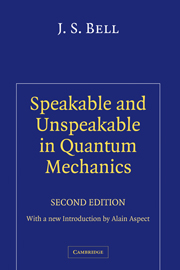Book contents
- Frontmatter
- Contents
- List of papers on quantum philosophy by J. S. Bell
- Preface to the first edition
- Acknowledgements
- Introduction: John Bell and the second quantum revolution
- 1 On the problem of hidden variables in quantum mechanics
- 2 On the Einstein–Podolsky–Rosen paradox
- 3 The moral aspect of quantum mechanics
- 4 Introduction to the hidden-variable question
- 5 Subject and object
- 6 On wave packet reduction in the Coleman–Hepp model
- 7 The theory of local beables
- 8 Locality in quantum mechanics: reply to critics
- 9 How to teach special relativity
- 10 Einstein–Podolsky–Rosen experiments
- 11 The measurement theory of Everett and de Broglie's pilot wave
- 12 Free variables and local causality
- 13 Atomic-cascade photons and quantum-mechanical nonlocality
- 14 de Broglie–Bohm, delayed-choice double-slit experiment, and density matrix
- 15 Quantum mechanics for cosmologists
- 16 Bertlmann's socks and the nature of reality
- 17 On the impossible pilot wave
- 18 Speakable and unspeakable in quantum mechanics
- 19 Beables for quantum field theory
- 20 Six possible worlds of quantum mechanics
- 21 EPR correlations and EPW distributions
- 22 Are there quantum jumps?
- 23 Against ‘measurement’
- 24 La nouvelle cuisine
10 - Einstein–Podolsky–Rosen experiments
Published online by Cambridge University Press: 11 April 2011
- Frontmatter
- Contents
- List of papers on quantum philosophy by J. S. Bell
- Preface to the first edition
- Acknowledgements
- Introduction: John Bell and the second quantum revolution
- 1 On the problem of hidden variables in quantum mechanics
- 2 On the Einstein–Podolsky–Rosen paradox
- 3 The moral aspect of quantum mechanics
- 4 Introduction to the hidden-variable question
- 5 Subject and object
- 6 On wave packet reduction in the Coleman–Hepp model
- 7 The theory of local beables
- 8 Locality in quantum mechanics: reply to critics
- 9 How to teach special relativity
- 10 Einstein–Podolsky–Rosen experiments
- 11 The measurement theory of Everett and de Broglie's pilot wave
- 12 Free variables and local causality
- 13 Atomic-cascade photons and quantum-mechanical nonlocality
- 14 de Broglie–Bohm, delayed-choice double-slit experiment, and density matrix
- 15 Quantum mechanics for cosmologists
- 16 Bertlmann's socks and the nature of reality
- 17 On the impossible pilot wave
- 18 Speakable and unspeakable in quantum mechanics
- 19 Beables for quantum field theory
- 20 Six possible worlds of quantum mechanics
- 21 EPR correlations and EPW distributions
- 22 Are there quantum jumps?
- 23 Against ‘measurement’
- 24 La nouvelle cuisine
Summary
I have been invited to speak on ‘foundations of quantum mechanics’ – and to a captive audience of high energy physicists! How can I hope to hold the attention of such serious people with philosophy? I will try to do so by concentrating on an area where some courageous experimenters have recently been putting philosophy to experimental test.
The area in question is that of Einstein, Podolsky, and Rosen. Suppose for example, that protons of a few MeV energy are incident on a hydrogen target. Occasionally one will scatter, causing a target proton to recoil. Suppose (Fig. 1) that we have counter telescopes T1 and T2 which register when suitable protons are going towards distant counters C1 and C2. With ideal arrangements registering of both T1 and T2 will then imply registering of both C1 and C2 after appropriate time decays. Suppose next that C1 and C2 are preceded by filters that pass only particles of given polarization, say those with spin projection + ½ along the z axis. Then one or both of C1 and C2 may fail to register. Indeed for protons of suitable energy one and only one of these counters will register on almost every suitable occasion – i.e., those occasions certified as suitable by telescopes T1 and T2. This is because proton–proton scattering at large angle and low energy, say a few MeV, goes mainly in S wave. But the antisymmetry of the final wave function then requires the antisymmetric singlet spin state.
- Type
- Chapter
- Information
- Speakable and Unspeakable in Quantum MechanicsCollected Papers on Quantum Philosophy, pp. 81 - 92Publisher: Cambridge University PressPrint publication year: 2004
- 1
- Cited by



